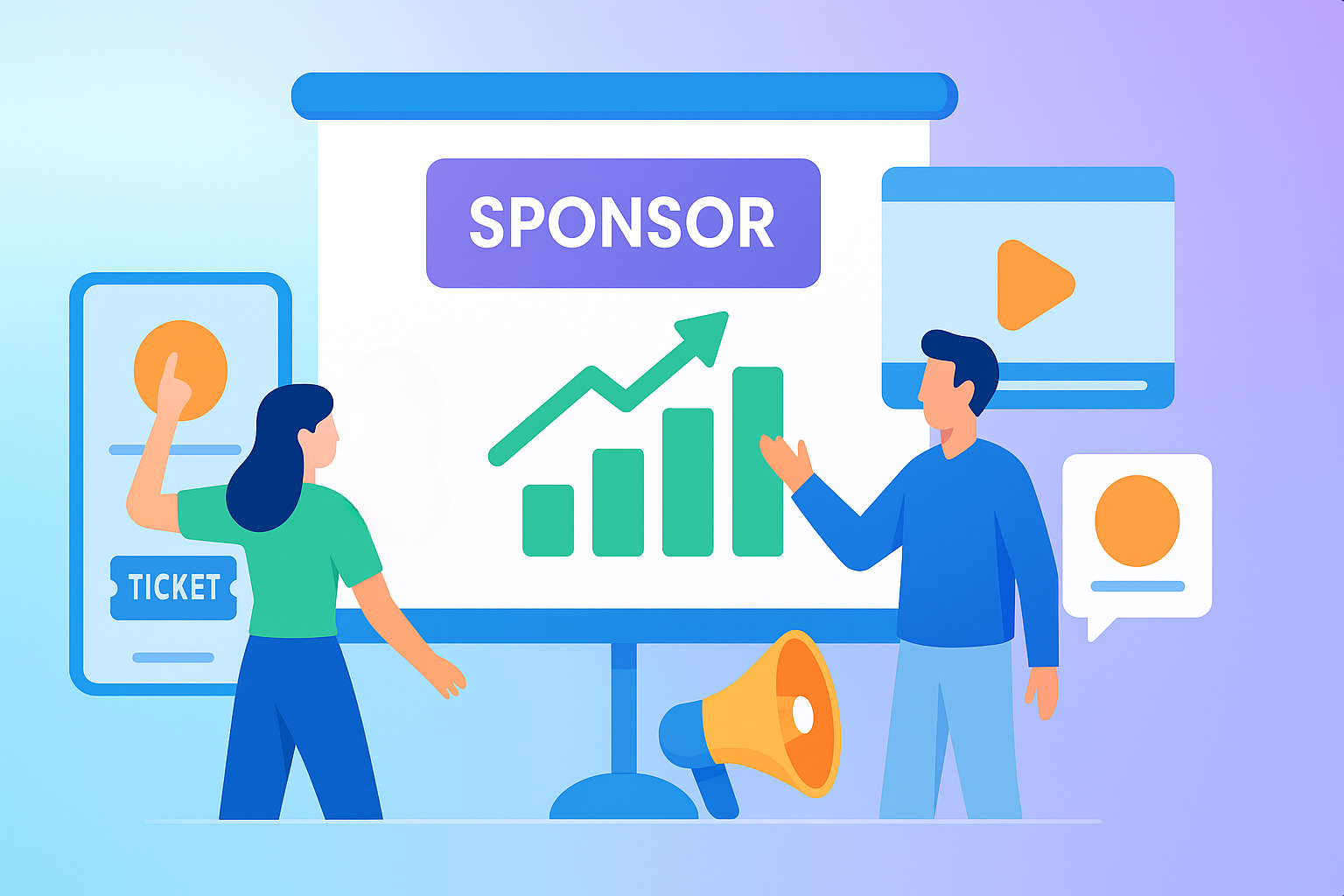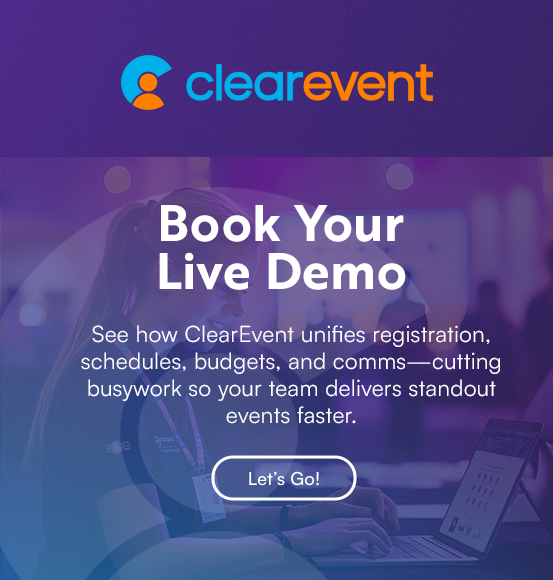5 Proven Ways to Boost Event Sponsor Visibility and ROI

Event sponsors don’t just want their logo on a banner; they want visibility, engagement, and measurable results. As an organizer, your challenge is showing sponsors clear value while keeping attendees engaged. Here are five proven ways to maximize sponsor promotion and deliver real ROI.
1. Strategic Event Branding Placement
Sponsor branding thrives when strategically positioned in high-traffic areas like entrances, lounges, or registration zones. For example, setting up branded welcome signage or sponsor booths near entryways ensures attendees see them multiple times.
To extend reach, combine physical and digital branding:
- Offer Wi-Fi networks with branded names.
- Display sponsor logos on your mobile event app and attendee facing pages.
- Play sponsor highlight videos during breaks or transitions.
- Keep branding consistent across signage, merchandise, social posts, and your event app.
Pro tip: Measure branding success with unique tracking links or post-event surveys to confirm recall and exposure. A thoughtful mix of physical and digital branding creates lasting impressions while demonstrating event sponsorship ROI.
2. Digital Display Integration
Digital displays are one of the most flexible sponsorship activation ideas. Position LED screens or projection walls in high-traffic areas like registration or refreshment zones. These can rotate sponsor logos, videos, or live announcements throughout the day.
Interactive options, such as touch-screen kiosks or QR codes, make it easy for attendees to engage directly with sponsor content. For events with multiple sponsors, rotate content based on sponsorship tiers to give premium sponsors more visibility.
Actionable insight: Always run technical checks before the event and prepare backup content to avoid blank screens. Sponsors value reliability just as much as visibility.
3. Sponsor Presentations That Engage
Presentations give sponsors the chance to directly connect with your audience. The key is to make them valuable, not salesy. Formats that work well include:
- Keynotes or fireside chats
- Panel discussions with industry leaders
- Interactive workshops or product demos
- Roundtables or Q&A sessions
Schedule sponsor-led sessions during peak hours (late morning or mid-afternoon) to maximize attendance. Encourage sponsors to focus on industry challenges and solutions rather than heavy promotion. Educational sessions that solve real challenges often generate stronger leads, making them one of the most effective event sponsorship strategies available to organizers.
Enhance engagement with live polls, Q&A apps, or post-session surveys. Share attendance and engagement metrics afterward to clearly demonstrate event sponsorship ROI.
4. Social Media Promotion
Social platforms extend sponsor visibility far beyond the venue. A well-planned sponsor promotion strategy taps into the before, during, and after cycle:
Before the event
- Announce sponsors using engaging visuals and hashtags. These simple event promotion ideas help build anticipation before your event begins.
- Run targeted ads to highlight their involvement.
During the event
- Share live updates with sponsor mentions.
- Use social walls or photo booths that encourage user-generated content.
- Highlight sponsor activations in Stories or short clips.
After the event
- Post highlights, sponsor shout-outs, and engagement stats.
- Share sponsor presentations or workshop replays.
Pro tip: Use platform-specific strategies: LinkedIn for B2B sponsors, Instagram for visual storytelling, and X (Twitter) for real-time updates. Tracking hashtag usage, mentions, and click-through rates helps sponsors see the true value of their participation.
5. Interactive Sponsorship Activation Ideas
Interactive activities turn passive visibility into memorable sponsor engagement. Go beyond static logos by creating experiences attendees will talk about. Examples include:
- A branded photo booth where attendees can instantly share images online.
- Gamified sponsor challenges with prizes for participants.
- Pop-up lounges or installations themed around the sponsor’s product or service.
Track participation rates, social shares, and on-site interactions to showcase impact. Interactive activations not only boost visibility but also generate organic social reach as attendees share their experiences. These increase the visibility for both your sponsors and your event!
Measuring Event Sponsorship ROI
Sponsors invest to see measurable returns, and it’s your job to make that value clear. Key metrics to track include:
- Digital engagement: page views, click-throughs, app activity
- Social media performance: hashtag usage, shares, mentions
- Interactive activity participation: number of participants, dwell time
- Lead generation outcomes: captured contacts or post-event sign-ups
- Session attendance: headcounts for sponsor presentations
Share these insights in a clear post-event report. Sponsors who see data-driven results are far more likely to return and increase their investment.
Final Thoughts
Strong sponsor engagement doesn’t happen by accident. It comes from careful planning and consistent execution. By combining branding, digital displays, sponsor presentations, social media, and interactive activations, you can deliver measurable ROI to your event sponsors while improving the attendee experience.
The bottom line: sponsors want visibility that truly matters. Deliver that, prove it with metrics, and you’ll build long-term sponsor relationships that grow with every event.
Frequently Asked Questions (FAQ)
What is a good ROI for event sponsorship?
A strong ROI typically means sponsors receive at least two dollars in value for every dollar they spend. This can include direct results like leads or sales as well as indirect benefits like increased brand awareness, stronger customer relationships, and long-term visibility.
How can I prove sponsorship value to my event sponsors?
You can prove value by tracking key metrics such as session attendance, social media mentions, digital engagement, and lead captures. Sharing a clear post-event report with this data demonstrates measurable ROI and builds trust with sponsors.
What are some low-cost sponsorship activation ideas?
Not every activation needs a big budget. Branded photo booths, sponsored contests, or dedicated social media shout-outs can all create strong sponsor engagement. These options are affordable, easy to implement, and still provide measurable value.
When should sponsor presentations be scheduled for maximum impact?
Sponsor-led sessions perform best when scheduled during late morning or mid-afternoon, when attendance is highest. Avoid early mornings or late-day slots, as attendees are often distracted or fatigued.
How do I keep sponsor branding from overwhelming the attendee experience?
Balance is key. Strategically place logos and activations in high-traffic areas while ensuring the event’s identity remains front and center. Sponsors see better results when their presence enhances, rather than overshadows, the attendee journey.
